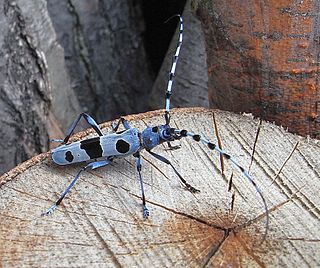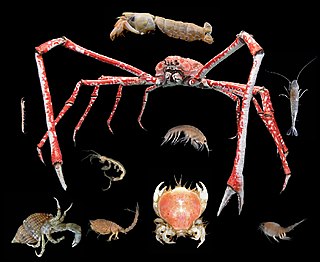Related Research Articles

Antennae, sometimes referred to as "feelers", are paired appendages used for sensing in arthropods.

Malacostraca is the largest of the six classes of crustaceans, containing about 40,000 living species, divided among 16 orders. Its members, the malacostracans, display a great diversity of body forms and include crabs, lobsters, crayfish, shrimp, krill, prawns, woodlice, amphipods, mantis shrimp, tongue-eating lice and many other less familiar animals. They are abundant in all marine environments and have colonised freshwater and terrestrial habitats. They are segmented animals, united by a common body plan comprising 20 body segments, and divided into a head, thorax, and abdomen.

Pauropods are small, pale, millipede-like arthropods. Around 830 species in twelve families are found worldwide, living in soil and leaf mold. They look rather like centipedes, or millipedes, and may be a sister group of the latter. However, this is controversial, as a close relationship with Symphyla has also been posited.

The mushroom bodies or corpora pedunculata are a pair of structures in the brain of insects, other arthropods, and some annelids. They are known to play a role in olfactory learning and memory. In most insects, the mushroom bodies and the lateral horn are the two higher brain regions that receive olfactory information from the antennal lobe via projection neurons. They were first identified and described by French biologist Félix Dujardin in 1850.
The nephridium is an invertebrate organ, found in pairs and performing a function similar to the vertebrate kidneys. Nephridia remove metabolic wastes from an animal's body. Nephridia come in two basic categories: metanephridia and protonephridia. All nephridia- and kidney- having animals belong to the clade Nephrozoa.
The antennal lobe is the primary olfactory brain area in insects. The antennal lobe is a sphere-shaped deutocerebral neuropil in the brain that receives input from the olfactory sensory neurons in the antennae and mouthparts. Functionally, it shares some similarities with the olfactory bulb in vertebrates. The anatomy and physiology function of the insect brain can be studied by dissecting open the insect brain and imaging or carrying out in vivo electrophysiological recordings from it.

The supraesophageal ganglion is the first part of the arthropod, especially insect, central nervous system. It receives and processes information from the first, second, and third metameres. The supraesophageal ganglion lies dorsal to the esophagus and consists of three parts, each a pair of ganglia that may be more or less pronounced, reduced, or fused depending on the genus:

The Entognatha are a class of wingless and ametabolous arthropods, which, together with the insects, makes up the subphylum Hexapoda. Their mouthparts are entognathous, meaning that they are retracted within the head, unlike the insects. Entognatha are apterous, meaning that they lack wings. The class contains three orders: Collembola, Diplura and Protura. These three groups were historically united with the now-obsolete order Thysanura to form the class Apterygota, but it has since been recognized that the hexapodous condition of these animals has evolved independently from that of insects, and independently within each order. The orders may not be closely related, and Entognatha is now considered to be a polyphyletic group.

The clypeus is one of the sclerites that make up the face of an arthropod. In insects, the clypeus delimits the lower margin of the face, with the labrum articulated along the ventral margin of the clypeus. The mandibles bracket the labrum, but do not touch the clypeus. The dorsal margin of the clypeus is below the antennal sockets. The clypeus is often well-defined by sulci ("grooves") along its lateral and dorsal margins, and is most commonly rectangular or trapezoidal in overall shape.

Hectopsyllidae is a small family of fleas, containing only the chigoe flea Tunga penetrans and the genus Hectopsylla. They were formerly known as Tungidae, and by authorities that demote the Pulicoidea to family rank they are treated as subfamily Hectopsyllinae. Only 2 genera with some handfuls of species are placed here nowadays, making further subdivision of the family unnecessary.

In insect anatomy the arista is a simple or variously modified apical or subapical bristle, arising from the third antennal segment. It is the evolutionary remains of antennal segments, and may sometimes show signs of segmentation. These segments are called aristameres. The arista may be bare and thin, sometime appearing no more than a simple bristle; pubescent, covered in short hairs; or plumose, covered in long hairs.
Kenyon cells are the intrinsic neurons of the mushroom body, a neuropil found in the brains of most arthropods and some annelids. They were first described by F. C. Kenyon in 1896. The number of Kenyon cells in an organism varies greatly between species. For example, in the fruit fly, Drosophila melanogaster, there are about 2,500 Kenyon cells per mushroom body, while in cockroaches there are about 230,000.

Laemophloeidae, "lined flat bark beetles," is a family in the superfamily Cucujoidea characterized by predominantly dorso-ventrally compressed bodies, head and pronotal discs bordered by ridges or grooves, and inverted male genitalia. Size range of adults is 1–5 mm (0.04–0.2 in) in length. Currently, it contains 40 genera and about 450 species, and is represented on all continents except Antarctica; species richness is greatest in the tropics.

Crustaceomorpha is a proposed clade of arthropods that includes crustaceans and numerous extinct groups. Synapomorphies for the clade are that the larval antenna is a feeding or locomotory organ, and there are six endopodal podomeres in post-antennal limbs.
The cephalon is the head section of an arthropod. It is a tagma, i.e., a specialized grouping of arthropod segments. The word cephalon derives from the Greek κεφαλή (kephalē), meaning "head".

The subphylum Hexapoda comprises most species of arthropods and includes the insects as well as three much smaller groups of wingless arthropods: Collembola, Protura, and Diplura. The Collembola are very abundant in terrestrial environments. Hexapods are named for their most distinctive feature: a consolidated thorax with three pairs of legs. Most other arthropods have more than three pairs of legs. Most recent studies have recovered Hexapoda as a subgroup of Crustacea.

Hololepta aequalis is a species of beetle belonging to the Histeridae family. It is found in North American countries such as Canada and the United States where it lives on an elevation of 525–1,370 metres (1,722–4,495 ft) and feeds on dead poplars. Besides poplars, it also feeds on pines, willows, and tulips. Its body is flat and is 8–11.5 millimetres (0.31–0.45 in) long. Its annuli is V-shaped while its palpi is horizontally projecting in front of the head. The species' antennal lobe is under anterior angles of its prothorax while its labrum is free.

Insect olfaction refers to the function of chemical receptors that enable insects to detect and identify volatile compounds for foraging, predator avoidance, finding mating partners and locating oviposition habitats. Thus, it is the most important sensation for insects. Most important insect behaviors must be timed perfectly which is dependent on what they smell and when they smell it. For example, olfaction is essential for locating host plants and hunting prey in many species of insects, such as the moth Deilephila elpenor and the wasp Polybia sericea, respectively.

Euperipatoides rowelli is an ovoviviparous species of velvet worm of the Peripatopsidae family. It is found in New South Wales and the Australian Capital Territory.
Lateral accessory lobes, or LALs are paired, symmetrical, systems of synaptic neuropils that exist in the brains of insects and other arthropods. Lateral accessory lobes are located inferiorly and laterally from ellipsoid body, anteriorly and laterally from the bulb. In the frontal section of the arthropod brain the LALs are projected as two triangles, called lateral triangles. The LALs have roughly pyramidal shape.
References
- ↑ Mizunami, Makoto; Yokohari, Fumio; Takahata, Masakazu (1999). "Exploration into the Adaptive Design of the Arthropod "Microbrain"". Zoological Science. Zoological Society of Japan. 16 (5): 703–709. doi: 10.2108/zsj.16.703 . ISSN 0289-0003. S2CID 86501328.